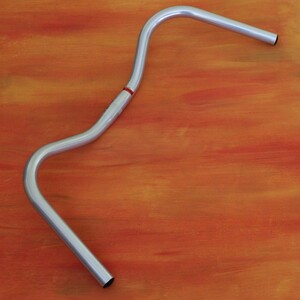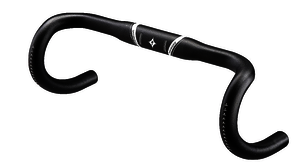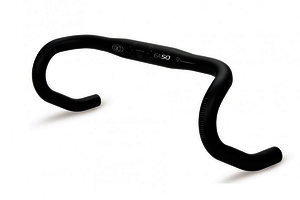As well as steering your bike, the handlebar affects your riding position and your comfort. A new one could cure aches and pains. Getting comfortable on your bike is largely about having the right handlebar and saddle in positions that are right for you.
Getting comfortable on your bike is largely about having the right handlebar and saddle in positions that are right for you. You can adjust the fit of your bike by moving the saddle and bar, which might require a new stem, and you can change bits of the bike itself. A new handlebar will affect where you put your hands and can radically change your riding posture.
Handlebar types
Discounting triathlon-style bars, there are two broad types: flats and drops. Some flats aren't flat and some drops are not very 'dropped' but they're easy enough to tell apart. Less obviously, they have a different diameter where the brake and gear levers attach – 23.8mm for most drops versus 22.2mm for flats – so the lever-type must match the handlebar-type. (The levers must also be compatible with the derailleurs and brakes, but that's another story.) The stem must fit the handlebar too. For both flats and drops, the most common sizes at the stem clamp are 25.4mm and 31.8mm.
Swapping your handlebar
Swapping one flat or drop bar for another is straightforward. Swapping a drop bar for a flat, or vice-versa, is more difficult. As well as new levers and cables, you will likely need a new stem. That's because a flat bar reduces the reach and a drop bar increases it.
The default hand position on drops is several centimetres in front of the end of the stem, on the brake hoods; on flats, the hands are level with or behind the stem. So a flat bar will sit you up more, while a drop bar will stretch you out more. A flat bar offers a wider, transverse grip that's great for control, whereas a drop bar offers more hand positions and a better aerodynamics.
Drop-bar anatomy
For maximum comfort, a drop-bar's width should roughly match the width of your shoulders. Drop-bar width is measured from centre to centre between the brake hoods. Sizes from 38-44cm are pretty common – others less so. The curve of drop-bar bends varies, both forwards (the reach) and downwards (the drop). Compact drop bars have a shallower drop and a shorter reach, making the 'hooks' on drop bars more usable for most people. Some drop bars curve in a more angular fashion to provide 'anatomic' handholds.
Flat-bar anatomy
Flat-bar width is measured across the widest point you can grip, typically end to end. A wider bar gives more steering leverage but is less aerodynamic and, by splaying your arms wider, makes you lean forward more. You can reduce flat-bar width with a hacksaw. (Make sure you cut the same amount from each end!)
Flat bars have 'rise', which is the amount the handgrips are higher than the stem clamp. They also sweep back and/or up at a (usually) slight angle, for improved wrist comfort.
Grips and tape for handlebars
Cork bar tape, with gel padding underneath if necessary, provides better shock absorbency and comfort for drop bars. For flat bars, grips that flare wider at the outer ends can help prevent hand discomfort. Most flat bars can also be fitted with bar ends, which provide an extra hand position.
Here's a selection of handlebars of both types.

XLC City/Trekking Butterfly bar
Named for its butterfly-winged shape, this type of handlebar gives more hand positions than any other flat bar. You can hold the front, sides and back. It also reduces the reach, as the bar curves forward and then back around to put the levers and controls much closer. It's used on continental-style touring bikes instead of drops but also suits city bikes.
£14.49
www.raleigh.co.uk
Atomlab Pimplite DJ bar
This strongly-built handlebar is intended for dirt-jumping, hence DJ. But anyone wanting a more upright riding position will appreciate its unusually high, 3-inch rise. The ends of the bars have a 7-degree upsweep and a 9-degree backsweep. As it's meant for a mountain bike, you'll want to saw and file it down for commuter use. It's also available in red. 710mm wide, 31.8mm diameter.
£29.99
www.denniswinter.com
Nitto Albatross
Roadster-style handlebars like this have dropped out of fashion recently, but offer a relaxed, upright riding position for more sedate cycling. The bar curves up and back, rising 50mm and putting your hands almost parallel to the direction of travel. Just add a wider, shock absorbing saddle, as weight will be transferred from your hands to your backside. 550mm wide, 25.4mm diameter.
£29.99
www.planetx.co.uk
Specialized Women's Expert Road Alloy Bar
Women's bikes are sometimes equipped with components that are sized more for men. This drop bar is properly designed for a rider with narrower shoulders, a shorter reach, and smaller hands. It's available in 36 and 38cm sizes as well as wider ones, the reach is only 75mm and the drop is 123mm. The bar is grooved for under-the-bar-tape cable routing. 360-420mm wide, 31.8mm diameter.
£31.50
www.specialized.com
Easton EA50 alloy drop handlebar
Like many modern drop bars, this Easton one is grooved to give better cable routing under the bar tape. It's relatively light, and it has a fairly compact reach (75mm) and drop (130mm). Its ergonomic bend gives a flatter, more comfortable hand position on the drops. It comes in a good range of widths too. 380-460mm wide, 31.8mm diameter.

Comments: